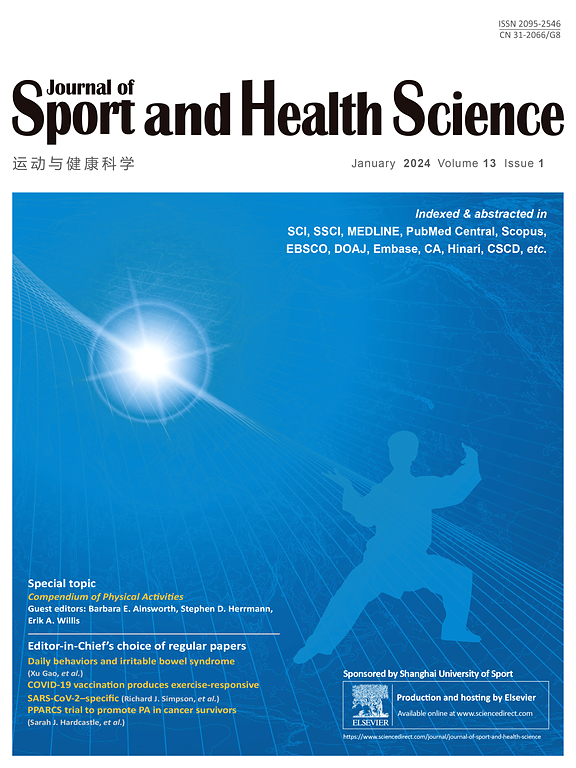The validity of automatic methods for estimating maturation stage in young athletes: A comparison of the Maturo smartphone application and sport science expert evaluations.
IF 10.3
1区 医学
Q1 HOSPITALITY, LEISURE, SPORT & TOURISM
引用次数: 0
Abstract
BACKGROUND Biological maturation refers to the progressive process through which individuals transition toward an adult state during growth and development. To address the challenges posed by differences in biological maturity and the limitations of existing testing methods, particularly in adolescent sports contexts, there is a pressing need for a non-invasive method that is convenient, accurate, and broadly applicable to monitor the biological maturity of adolescent athletes comprehensively. In response to this need, a maturity assessment method based on the smartphone application Maturo has been developed. This study evaluates the accuracy and validity of the Maturo software, an automated tool for estimating biological age and related maturation metrics METHODS: A sample of 103 actively training teenage athletes aged 9 - 17 years. The sample included 76 males (11.74 ±1.55, mean ± SD) and 27 females (age = 13.95 ±1.40), all without medical conditions that might impact growth or development. RESULTS Compared to traditional expert evaluations, the intraclass correlation coefficients (ICCs) and Pearson correlation coefficients demonstrated reliable positive correlations and significant agreement between the Maturo software and expert methods across multiple metrics, such as biological age (ICC = 0.965, R = 0.97), corrected biological age (ICC = 0.973, R = 0.99), predicted adult height (ICC = 0.991, R = 0.99), and percentage of adult height achieved (ICC = 0.955, R = 0.97). The Bland-Altman plots provided additional evidence of the validity of the Maturo software estimations, showing low systematic error in most measures. The linear regression analysis produced excellent adjusted R-squared values: 0.95 for biological age and 0.99 for anticipated adult height. The Maturo approach demonstrated a high level of dependability in classifying teenagers into groups based on their maturity status and timing. The kappa coefficients of 0.93 for maturity status and 0.82 for maturity timing indicate a nearly perfect agreement with the expert technique. CONCLUSION While the Maturo software's non-invasive nature, cost-effectiveness, and ease of use could make it a potential tool for regular monitoring of growth and maturation in young athletes, its promising results in assessing maturation should be interpreted with caution due to limitations such as sample size and demographic constraints. Further longitude research with larger and more diverse populations is needed to validate these preliminary findings and strengthen the evidence for its broader Applicability.年轻运动员成熟阶段自动评估方法的有效性:Maturo智能手机应用程序与运动科学专家评估的比较。
生物学成熟是指个体在生长发育过程中向成人状态过渡的渐进过程。为了解决生物成熟度差异带来的挑战和现有检测方法的局限性,特别是在青少年运动环境下,迫切需要一种方便、准确、广泛适用的非侵入性方法来全面监测青少年运动员的生物成熟度。针对这一需求,开发了基于智能手机应用程序Maturo的成熟度评估方法。本研究评估了Maturo软件的准确性和有效性,Maturo软件是一种估算生物年龄和相关成熟指标的自动化工具。方法:103名9 - 17岁的积极训练的青少年运动员为样本。样本包括76名男性(11.74±1.55,mean±SD)和27名女性(年龄 = 13.95±1.40),均无可能影响生长发育的疾病。RESULTSCompared传统专家评估,组内相关系数(可以)和皮尔逊相关系数证明可靠的正相关性和重大协议Maturo软件和专家方法跨多个指标,如生理年龄(ICC = 0.965 R = 0.97),纠正生理年龄(ICC = 0.973 R = 0.99),预测成年身高(ICC = 0.991 R = 0.99),和成人身高比例(ICC = 0.955 R = 0.97)。Bland-Altman图为Maturo软件估计的有效性提供了额外的证据,在大多数测量中显示出低的系统误差。线性回归分析产生了极好的调整后r方值:生物年龄为0.95,预期成人身高为0.99。Maturo方法在根据青少年的成熟状态和时间将其分类方面显示出高度的可靠性。成熟度状态的kappa系数为0.93,成熟度时间的kappa系数为0.82,与专家技术的kappa系数基本一致。尽管Maturo软件的非侵入性、成本效益和易用性使其成为定期监测年轻运动员生长和成熟的潜在工具,但由于样本量和人口统计学限制等限制,其在评估成熟方面的有希望的结果应谨慎解读。需要对更大、更多样化的人群进行进一步的经度研究,以验证这些初步发现,并为其更广泛的适用性加强证据。
本文章由计算机程序翻译,如有差异,请以英文原文为准。
求助全文
约1分钟内获得全文
求助全文
来源期刊

Journal of Sport and Health Science
SPORT SCIENCES-
CiteScore
18.30
自引率
1.70%
发文量
101
审稿时长
22 weeks
期刊介绍:
The Journal of Sport and Health Science (JSHS) is an international, multidisciplinary journal that aims to advance the fields of sport, exercise, physical activity, and health sciences. Published by Elsevier B.V. on behalf of Shanghai University of Sport, JSHS is dedicated to promoting original and impactful research, as well as topical reviews, editorials, opinions, and commentary papers.
With a focus on physical and mental health, injury and disease prevention, traditional Chinese exercise, and human performance, JSHS offers a platform for scholars and researchers to share their findings and contribute to the advancement of these fields. Our journal is peer-reviewed, ensuring that all published works meet the highest academic standards.
Supported by a carefully selected international editorial board, JSHS upholds impeccable integrity and provides an efficient publication platform. We invite submissions from scholars and researchers worldwide, and we are committed to disseminating insightful and influential research in the field of sport and health science.
 求助内容:
求助内容: 应助结果提醒方式:
应助结果提醒方式:


